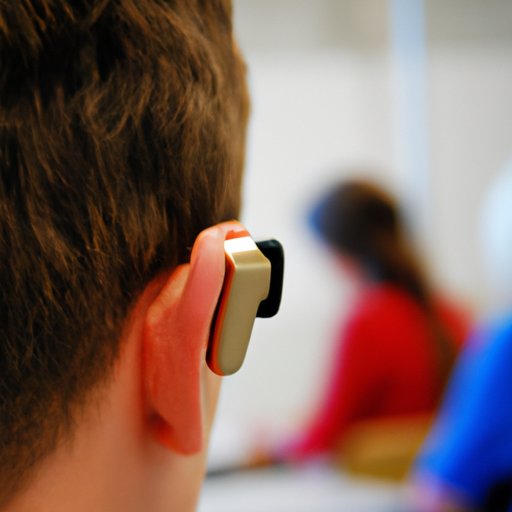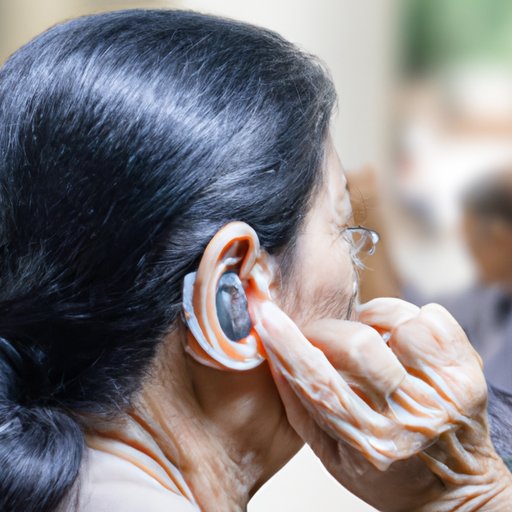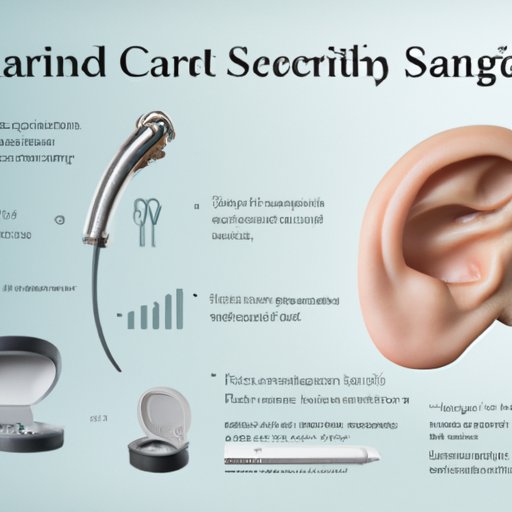Introduction
A cochlear implant is a surgically implanted device that is designed to provide a sense of sound to a person who is deaf or severely hard of hearing. This type of implant works by bypassing the damaged part of the ear and directly stimulating the auditory nerve. In this way, it can help those with severe hearing loss to hear sounds that would otherwise be impossible for them to detect.
A Step-by-Step Guide to How Cochlear Implants Work
The cochlear implant consists of two main parts: an external component and an internal component. The external component is composed of a microphone, a speech processor, and a transmitter. The microphone picks up sound waves, which are then converted into electrical signals by the speech processor. These signals are then sent to the internal component via the transmitter. The internal component is composed of an electrode array, a receiver, and a stimulator. The electrode array is inserted into the cochlea, where it receives the electrical signals from the external component. The receiver then amplifies these signals and sends them to the stimulator, which stimulates the auditory nerve and sends the signals to the brain.

Exploring the Technology Behind Cochlear Implants
Cochlear implants are highly sophisticated devices that require regular programming and monitoring to ensure optimal performance. This is done through a process known as “mapping,” during which a hearing health professional adjusts the settings of the device to best suit the individual’s specific hearing needs. Mapping is typically done every 3 to 6 months, depending on the individual’s needs.
In addition to mapping, hearing health professionals will also monitor the implant’s performance to check for any issues that may arise. This may include checking the battery life, making sure the microphone is working properly, and ensuring that the speech processor is functioning correctly. By regularly checking the implant’s performance, hearing health professionals can ensure that it is providing the best possible hearing experience for the individual.

How a Cochlear Implant Can Help Deaf and Hard of Hearing People
Cochlear implants can have a profound impact on the lives of those who are deaf or hard of hearing. By providing improved access to sound, they can help individuals to better understand speech, engage in conversations, and participate in activities that involve listening. A study conducted by the National Institute on Deafness and Other Communication Disorders (NIDCD) found that those who received a cochlear implant reported significant improvements in their speech understanding and overall quality of life.
“The results of our study illustrate the importance of early intervention for children with hearing loss,” said lead researcher Dr. Judith Gravel. “With appropriate treatment, such as cochlear implantation, these children can develop language and communication skills and enjoy a better quality of life.”
The Science Behind Cochlear Implants: How Do They Work?
Cochlear implants use a combination of technology and science to overcome damage to the inner ear. The microphone captures sound waves and converts them into electrical signals, which are then sent to the electrode array in the cochlea. The electrode array stimulates the auditory nerve, sending the signals to the brain where they are interpreted as sound. This allows the user to hear sound that would otherwise be impossible for them to detect due to damage to the inner ear.
Cochlear implants can also enhance the hearing ability of those with partial hearing loss. By providing more detailed information about sound, cochlear implants can help users to better distinguish between different sounds and understand speech more clearly.
An Overview of How Cochlear Implants Enhance Hearing Ability
Cochlear implants can help to improve speech perception in a number of ways. First, they can help to reduce background noise, making it easier to focus on the sounds that are important. They can also help to improve pitch perception, allowing the user to better distinguish between different notes. Finally, they can help to improve sound localization, allowing the user to tell where a sound is coming from.
In addition to improving speech perception, cochlear implants can also help to improve the quality of life of those with hearing loss. Studies have shown that those with cochlear implants report increased levels of social interaction and overall satisfaction with their lives. They are also able to better communicate with family and friends, leading to improved relationships.
Conclusion
Cochlear implants are an incredible technology that can help those with severe hearing loss to hear sounds that would otherwise be impossible for them to detect. By bypassing the damaged part of the ear and directly stimulating the auditory nerve, cochlear implants can help to improve speech perception, sound localization, and overall quality of life. With regular programming and maintenance, as well as therapy to maximize the benefits of the implant, those with hearing loss can enjoy improved hearing and a better quality of life.
(Note: Is this article not meeting your expectations? Do you have knowledge or insights to share? Unlock new opportunities and expand your reach by joining our authors team. Click Registration to join us and share your expertise with our readers.)
